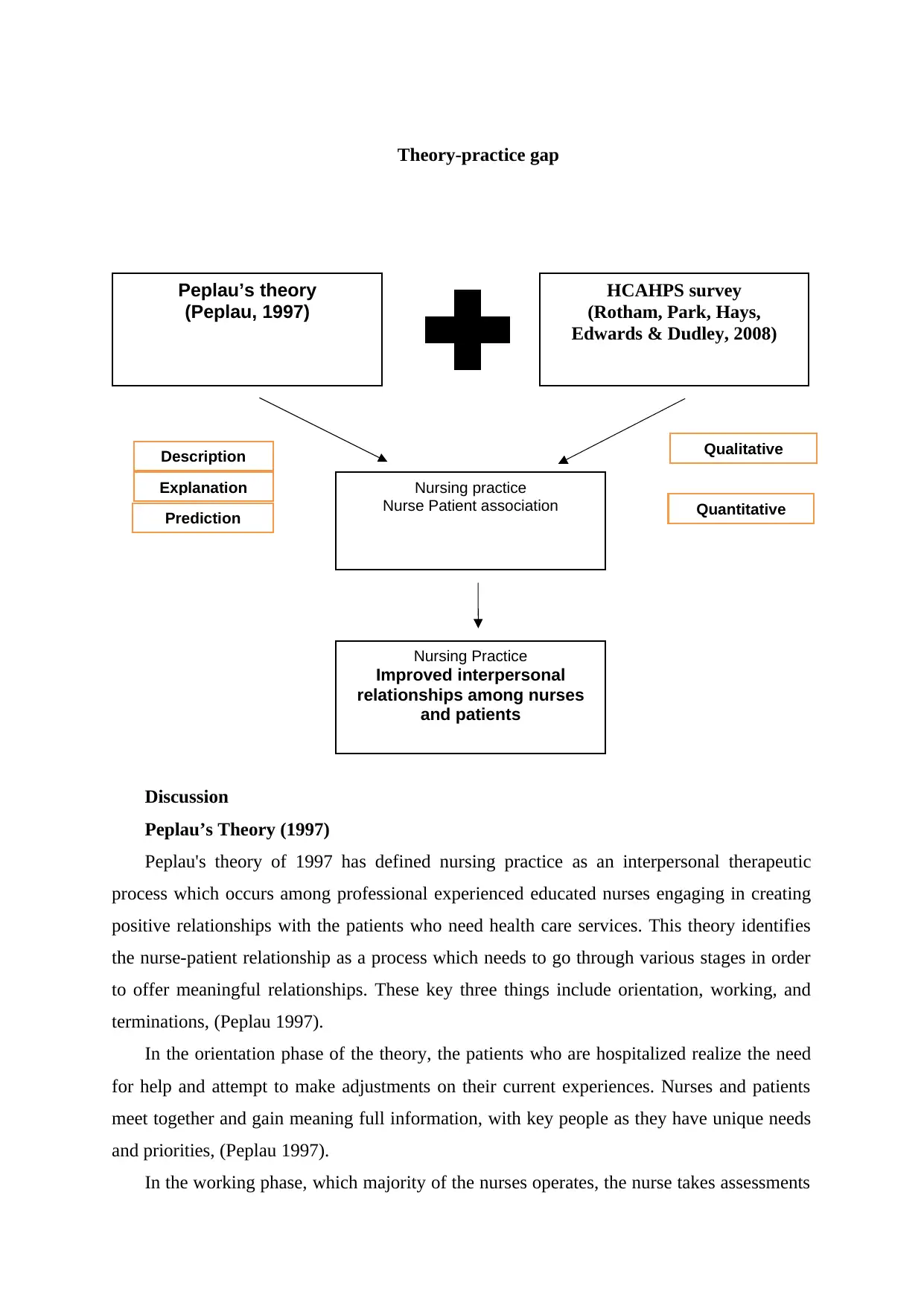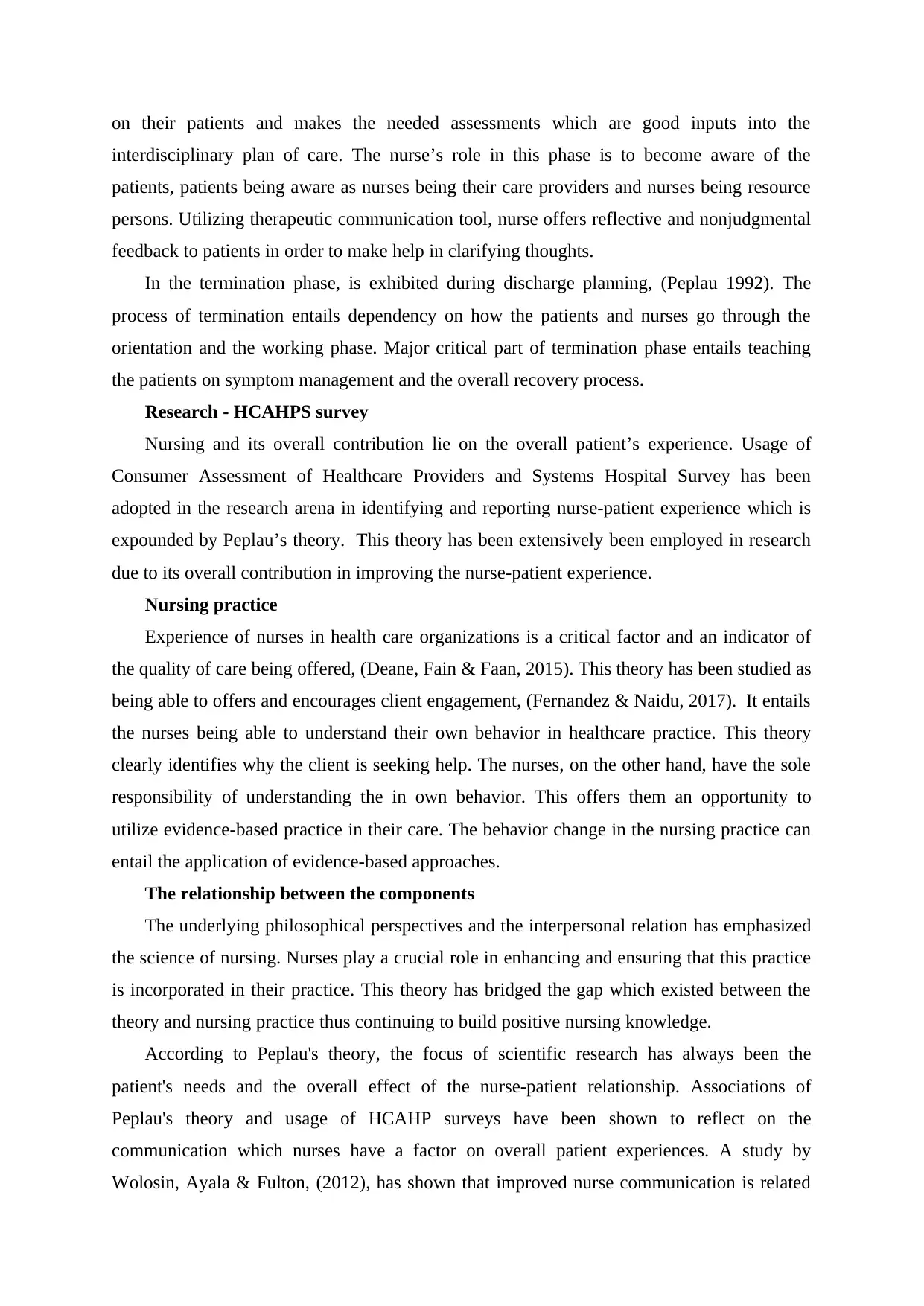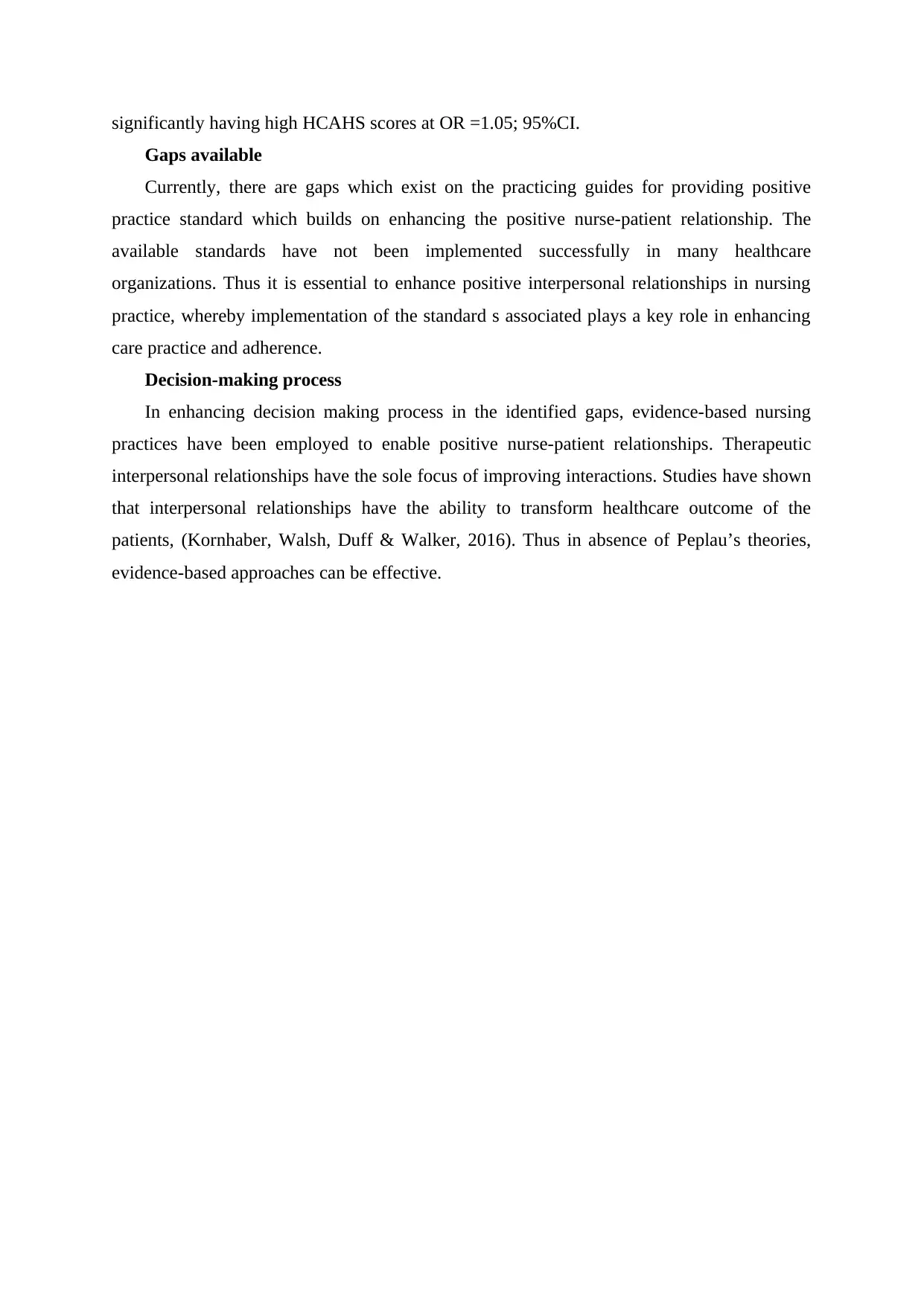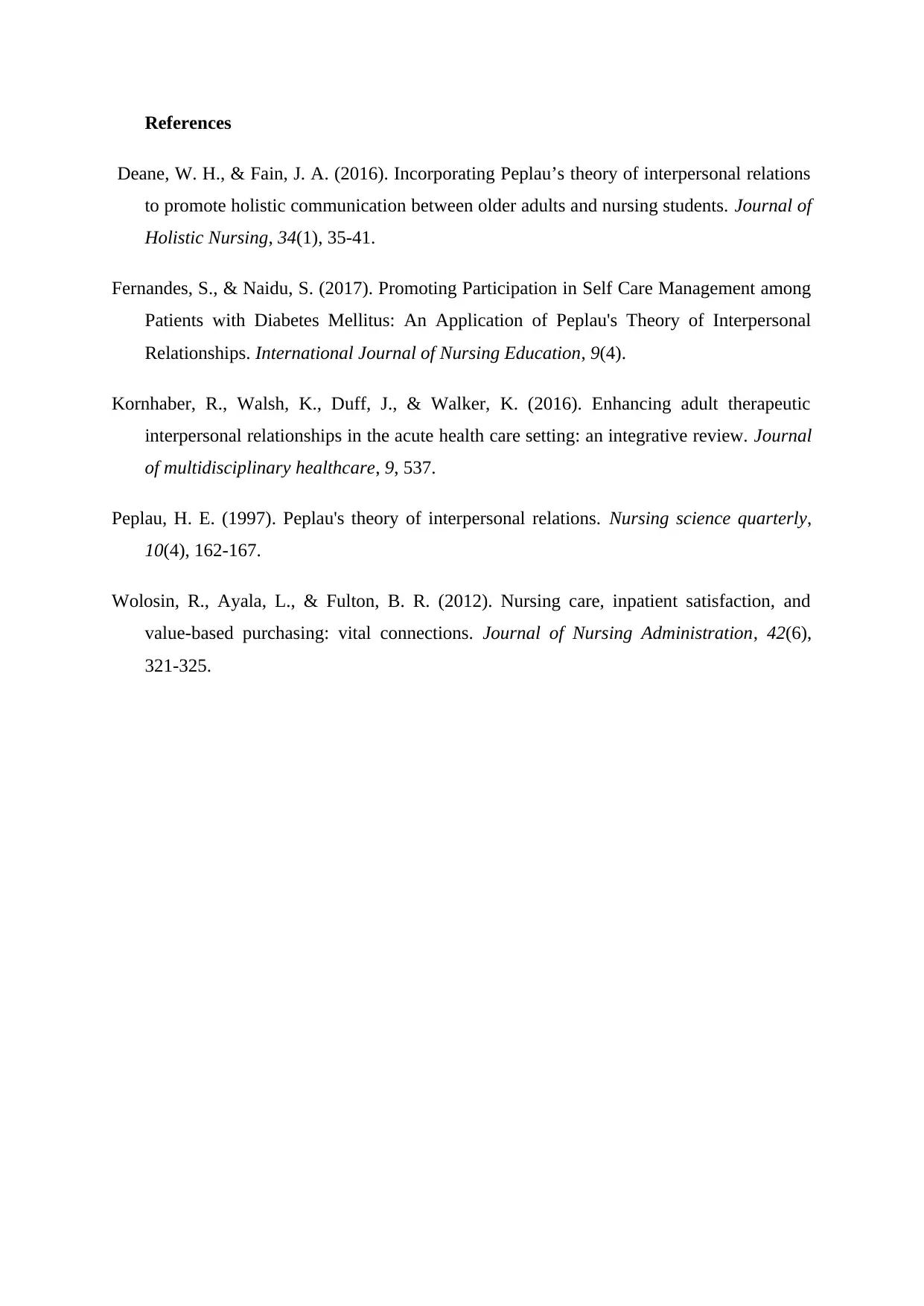Application of Peplau's Theory to the Nursing Theory-Practice Gap
VerifiedAdded on 2023/06/03
|5
|1038
|326
Report
AI Summary
This report examines the theory-practice gap in nursing, focusing on Peplau's theory of interpersonal relations (1997) and its application in healthcare. The report explores the nurse-patient relationship as a therapeutic process, emphasizing the stages of orientation, working, and termination. It discusses the role of the HCAHPS survey in evaluating patient experience and how it aligns with Peplau's theory. The report highlights the importance of nurses' experience and behavior in healthcare practice, emphasizing the application of evidence-based approaches. It identifies gaps in current practice guidelines and emphasizes the need for positive interpersonal relationships. The report also discusses the decision-making process in addressing these gaps, focusing on evidence-based nursing practices and therapeutic interpersonal relationships to improve patient outcomes. References include Deane & Fain (2016), Fernandes & Naidu (2017), Kornhaber et al. (2016), and Wolosin et al. (2012), providing further insights into the subject matter.

University
Assignment
Student Name
Tutor
Assignment
Student Name
Tutor
Paraphrase This Document
Need a fresh take? Get an instant paraphrase of this document with our AI Paraphraser

Theory-practice gap
Discussion
Peplau’s Theory (1997)
Peplau's theory of 1997 has defined nursing practice as an interpersonal therapeutic
process which occurs among professional experienced educated nurses engaging in creating
positive relationships with the patients who need health care services. This theory identifies
the nurse-patient relationship as a process which needs to go through various stages in order
to offer meaningful relationships. These key three things include orientation, working, and
terminations, (Peplau 1997).
In the orientation phase of the theory, the patients who are hospitalized realize the need
for help and attempt to make adjustments on their current experiences. Nurses and patients
meet together and gain meaning full information, with key people as they have unique needs
and priorities, (Peplau 1997).
In the working phase, which majority of the nurses operates, the nurse takes assessments
Quantitative
Qualitative
Peplau’s theory
(Peplau, 1997)
HCAHPS survey
(Rotham, Park, Hays,
Edwards & Dudley, 2008)
Nursing practice
Nurse Patient association
Nursing Practice
Improved interpersonal
relationships among nurses
and patients
Description
Explanation
Prediction
Discussion
Peplau’s Theory (1997)
Peplau's theory of 1997 has defined nursing practice as an interpersonal therapeutic
process which occurs among professional experienced educated nurses engaging in creating
positive relationships with the patients who need health care services. This theory identifies
the nurse-patient relationship as a process which needs to go through various stages in order
to offer meaningful relationships. These key three things include orientation, working, and
terminations, (Peplau 1997).
In the orientation phase of the theory, the patients who are hospitalized realize the need
for help and attempt to make adjustments on their current experiences. Nurses and patients
meet together and gain meaning full information, with key people as they have unique needs
and priorities, (Peplau 1997).
In the working phase, which majority of the nurses operates, the nurse takes assessments
Quantitative
Qualitative
Peplau’s theory
(Peplau, 1997)
HCAHPS survey
(Rotham, Park, Hays,
Edwards & Dudley, 2008)
Nursing practice
Nurse Patient association
Nursing Practice
Improved interpersonal
relationships among nurses
and patients
Description
Explanation
Prediction

on their patients and makes the needed assessments which are good inputs into the
interdisciplinary plan of care. The nurse’s role in this phase is to become aware of the
patients, patients being aware as nurses being their care providers and nurses being resource
persons. Utilizing therapeutic communication tool, nurse offers reflective and nonjudgmental
feedback to patients in order to make help in clarifying thoughts.
In the termination phase, is exhibited during discharge planning, (Peplau 1992). The
process of termination entails dependency on how the patients and nurses go through the
orientation and the working phase. Major critical part of termination phase entails teaching
the patients on symptom management and the overall recovery process.
Research - HCAHPS survey
Nursing and its overall contribution lie on the overall patient’s experience. Usage of
Consumer Assessment of Healthcare Providers and Systems Hospital Survey has been
adopted in the research arena in identifying and reporting nurse-patient experience which is
expounded by Peplau’s theory. This theory has been extensively been employed in research
due to its overall contribution in improving the nurse-patient experience.
Nursing practice
Experience of nurses in health care organizations is a critical factor and an indicator of
the quality of care being offered, (Deane, Fain & Faan, 2015). This theory has been studied as
being able to offers and encourages client engagement, (Fernandez & Naidu, 2017). It entails
the nurses being able to understand their own behavior in healthcare practice. This theory
clearly identifies why the client is seeking help. The nurses, on the other hand, have the sole
responsibility of understanding the in own behavior. This offers them an opportunity to
utilize evidence-based practice in their care. The behavior change in the nursing practice can
entail the application of evidence-based approaches.
The relationship between the components
The underlying philosophical perspectives and the interpersonal relation has emphasized
the science of nursing. Nurses play a crucial role in enhancing and ensuring that this practice
is incorporated in their practice. This theory has bridged the gap which existed between the
theory and nursing practice thus continuing to build positive nursing knowledge.
According to Peplau's theory, the focus of scientific research has always been the
patient's needs and the overall effect of the nurse-patient relationship. Associations of
Peplau's theory and usage of HCAHP surveys have been shown to reflect on the
communication which nurses have a factor on overall patient experiences. A study by
Wolosin, Ayala & Fulton, (2012), has shown that improved nurse communication is related
interdisciplinary plan of care. The nurse’s role in this phase is to become aware of the
patients, patients being aware as nurses being their care providers and nurses being resource
persons. Utilizing therapeutic communication tool, nurse offers reflective and nonjudgmental
feedback to patients in order to make help in clarifying thoughts.
In the termination phase, is exhibited during discharge planning, (Peplau 1992). The
process of termination entails dependency on how the patients and nurses go through the
orientation and the working phase. Major critical part of termination phase entails teaching
the patients on symptom management and the overall recovery process.
Research - HCAHPS survey
Nursing and its overall contribution lie on the overall patient’s experience. Usage of
Consumer Assessment of Healthcare Providers and Systems Hospital Survey has been
adopted in the research arena in identifying and reporting nurse-patient experience which is
expounded by Peplau’s theory. This theory has been extensively been employed in research
due to its overall contribution in improving the nurse-patient experience.
Nursing practice
Experience of nurses in health care organizations is a critical factor and an indicator of
the quality of care being offered, (Deane, Fain & Faan, 2015). This theory has been studied as
being able to offers and encourages client engagement, (Fernandez & Naidu, 2017). It entails
the nurses being able to understand their own behavior in healthcare practice. This theory
clearly identifies why the client is seeking help. The nurses, on the other hand, have the sole
responsibility of understanding the in own behavior. This offers them an opportunity to
utilize evidence-based practice in their care. The behavior change in the nursing practice can
entail the application of evidence-based approaches.
The relationship between the components
The underlying philosophical perspectives and the interpersonal relation has emphasized
the science of nursing. Nurses play a crucial role in enhancing and ensuring that this practice
is incorporated in their practice. This theory has bridged the gap which existed between the
theory and nursing practice thus continuing to build positive nursing knowledge.
According to Peplau's theory, the focus of scientific research has always been the
patient's needs and the overall effect of the nurse-patient relationship. Associations of
Peplau's theory and usage of HCAHP surveys have been shown to reflect on the
communication which nurses have a factor on overall patient experiences. A study by
Wolosin, Ayala & Fulton, (2012), has shown that improved nurse communication is related
⊘ This is a preview!⊘
Do you want full access?
Subscribe today to unlock all pages.

Trusted by 1+ million students worldwide

significantly having high HCAHS scores at OR =1.05; 95%CI.
Gaps available
Currently, there are gaps which exist on the practicing guides for providing positive
practice standard which builds on enhancing the positive nurse-patient relationship. The
available standards have not been implemented successfully in many healthcare
organizations. Thus it is essential to enhance positive interpersonal relationships in nursing
practice, whereby implementation of the standard s associated plays a key role in enhancing
care practice and adherence.
Decision-making process
In enhancing decision making process in the identified gaps, evidence-based nursing
practices have been employed to enable positive nurse-patient relationships. Therapeutic
interpersonal relationships have the sole focus of improving interactions. Studies have shown
that interpersonal relationships have the ability to transform healthcare outcome of the
patients, (Kornhaber, Walsh, Duff & Walker, 2016). Thus in absence of Peplau’s theories,
evidence-based approaches can be effective.
Gaps available
Currently, there are gaps which exist on the practicing guides for providing positive
practice standard which builds on enhancing the positive nurse-patient relationship. The
available standards have not been implemented successfully in many healthcare
organizations. Thus it is essential to enhance positive interpersonal relationships in nursing
practice, whereby implementation of the standard s associated plays a key role in enhancing
care practice and adherence.
Decision-making process
In enhancing decision making process in the identified gaps, evidence-based nursing
practices have been employed to enable positive nurse-patient relationships. Therapeutic
interpersonal relationships have the sole focus of improving interactions. Studies have shown
that interpersonal relationships have the ability to transform healthcare outcome of the
patients, (Kornhaber, Walsh, Duff & Walker, 2016). Thus in absence of Peplau’s theories,
evidence-based approaches can be effective.
Paraphrase This Document
Need a fresh take? Get an instant paraphrase of this document with our AI Paraphraser

References
Deane, W. H., & Fain, J. A. (2016). Incorporating Peplau’s theory of interpersonal relations
to promote holistic communication between older adults and nursing students. Journal of
Holistic Nursing, 34(1), 35-41.
Fernandes, S., & Naidu, S. (2017). Promoting Participation in Self Care Management among
Patients with Diabetes Mellitus: An Application of Peplau's Theory of Interpersonal
Relationships. International Journal of Nursing Education, 9(4).
Kornhaber, R., Walsh, K., Duff, J., & Walker, K. (2016). Enhancing adult therapeutic
interpersonal relationships in the acute health care setting: an integrative review. Journal
of multidisciplinary healthcare, 9, 537.
Peplau, H. E. (1997). Peplau's theory of interpersonal relations. Nursing science quarterly,
10(4), 162-167.
Wolosin, R., Ayala, L., & Fulton, B. R. (2012). Nursing care, inpatient satisfaction, and
value-based purchasing: vital connections. Journal of Nursing Administration, 42(6),
321-325.
Deane, W. H., & Fain, J. A. (2016). Incorporating Peplau’s theory of interpersonal relations
to promote holistic communication between older adults and nursing students. Journal of
Holistic Nursing, 34(1), 35-41.
Fernandes, S., & Naidu, S. (2017). Promoting Participation in Self Care Management among
Patients with Diabetes Mellitus: An Application of Peplau's Theory of Interpersonal
Relationships. International Journal of Nursing Education, 9(4).
Kornhaber, R., Walsh, K., Duff, J., & Walker, K. (2016). Enhancing adult therapeutic
interpersonal relationships in the acute health care setting: an integrative review. Journal
of multidisciplinary healthcare, 9, 537.
Peplau, H. E. (1997). Peplau's theory of interpersonal relations. Nursing science quarterly,
10(4), 162-167.
Wolosin, R., Ayala, L., & Fulton, B. R. (2012). Nursing care, inpatient satisfaction, and
value-based purchasing: vital connections. Journal of Nursing Administration, 42(6),
321-325.
1 out of 5
Related Documents
Your All-in-One AI-Powered Toolkit for Academic Success.
+13062052269
info@desklib.com
Available 24*7 on WhatsApp / Email
![[object Object]](/_next/static/media/star-bottom.7253800d.svg)
Unlock your academic potential
Copyright © 2020–2025 A2Z Services. All Rights Reserved. Developed and managed by ZUCOL.





